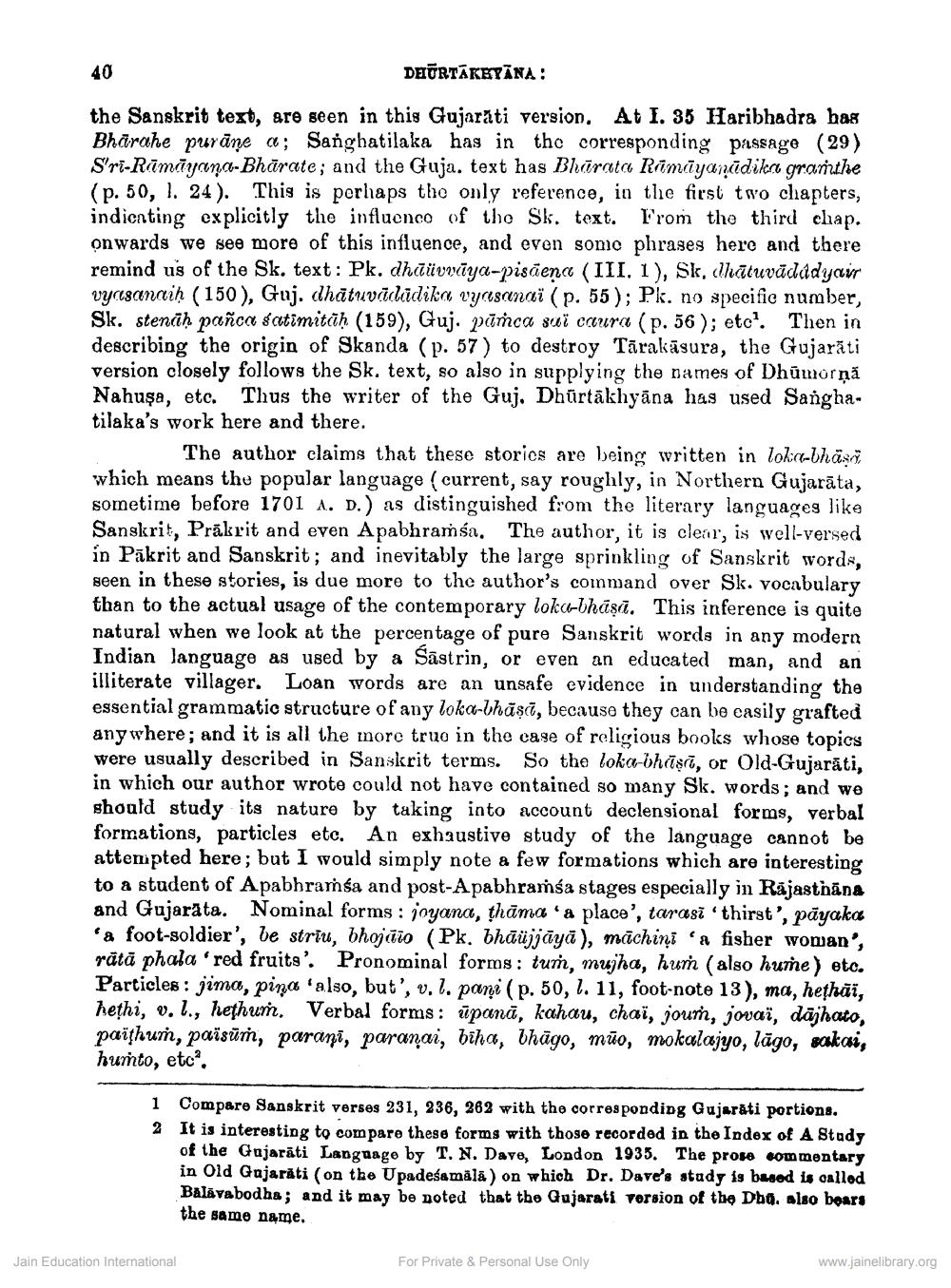________________
40
DHTRTĀKBYĀNA:
the Sanskrit text, are seen in this Gujarāti version. At I. 35 Haribhadra has Bhārahe purāne a; Sanghatilaka has in the corresponding passage (29) Sri-Rāmāyana-Bhārate; and the Guja. text has Bharata Rāmīyanādilcro granthe (p. 50, I. 24). This is perhaps the only reference, in the first two chapters, indicnting explicitly the influenco of the Sk. text. From the third chap. onwards we see more of this influence, and even some phrases here and there remind us of the Sk. text: Pk. dhcüvvüya-pisāena (III, 1), Sk, ahātuvādddyair vycesanaiḥ (150), Guj. dhātuvadūdika vycesanaï (p. 55); Pk. no specific number, Sk. stenāḥ pañca datimitāḥ (159), Guj. pūńca suï caura (p. 56 ); etc. Then in describing the origin of Skanda (p. 57 ) to destroy Tārakäsura, the Gujarāti version closely follows the Sk, text, so also in supplying the names of Dhūmorņā Nahuşa, etc. Thus the writer of the Guj. Dhürtākhyāna has used Sanghatilaka's work here and there.
The author claims that these stories are being written in loka-bhäsı which means the popular language (current, say roughly, in Northern Gujarāta, sometime before 1701 A. D.) as distinguished from the literary languages like Sanskrit, Prākrit and even A pabhraíśa. The author, it is clear, is well-versed in Pākrit and Sanskrit; and inevitably the large sprinkling of Sanskrit words, seen in these stories, is due more to the author's command over Sk. vocabulary than to the actual usage of the contemporary loka-bhāṣā. This inference is quite natural when we look at the percentage of pure Sanskrit words in any modern Indian language as used by a Šāstrin, or even an educated man, and an illiterate villager. Loan words are an unsafe evidence in understanding the essential grammatic structure of any loka-bhāści, because they can be easily grafted anywhere; and it is all the more true in the case of religious books whose topics were usually described in Sanskrit terms. So the loka-bhísī, or Old-Gujarāti, in which our author wrote could not have contained so many Sk. words; and we should study its nature by taking into account declensional forms, verbal formations, particles etc. An exhaustive study of the language cannot be attempted here; but I would simply note a few formations which are interesting to a student of Apabhramba and post-Apabhramsa stages especially in Rajasthāna and Gujarata. Nominal forms : joyana, thāma 'a place', tarasi 'thirst', pāyaka 'a foot-soldier', be striu, bhojaio (Pk, bhāüjjāyā), māchini 'a fisher woman', rätā phala 'red fruits'. Pronominal forms: tur, mujha, hur (also hure) etc. Particles: jima, pina 'also, but', v.l. pani (p. 50, l. 11, foot-note 13), ma, hethūī, hethi, v. l., hethur. Verbal forms: ūpanā, kahau, chai, jour, jovai, dājhato, paithum, païsūr, paranī, paranai, biha, bhāgo, mūo, mokalajyo, lāgo, sakai, hurto, etc.
1 Compare Sanskrit verses 231, 236, 262 with the corresponding Gujarati portions. 2 It is interesting to compare these forms with those recorded in the Index of A Study
of the Gujaräti Language by T. N. Dave, London 1935. The prose commentary in Old Gajarăti (on the Upadeśamālā) on which Dr. Dave's study is based is called Balāvabodhs; and it may be noted that the Gujarati version of the Dbo. also boars the same name.
Jain Education International
For Private & Personal Use Only
www.jainelibrary.org




